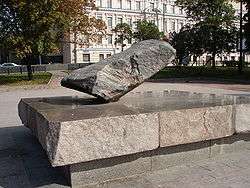Day of Remembrance of the Victims of Political Repressions
| Day of Remembrance of the Victims of Political Repressions | |
|---|---|
| Date | October 30 |
| Next time | 30 October 2018 |
| Frequency | annual |

Day of Remembrance of the Victims of Political Repressions (Russian: День памяти жертв политических репрессий), is an annual day of remembrance for victims of political repression in the Soviet Union.
Day of Remembrance of the Victims of Political Repressions has been commemorated on October 30, since 1991, in former Soviet republics, except for Ukraine, which has its own annual Day of Remembrance for the victims of political repressions by the Soviet regime on the third Sunday of May. In 1991, the Supreme Soviet of Russia officially established 30 October as the Day of Remembrance of the Victims of Political Repressions.[1][2] This day is also officially a public holiday in the Russian Federation.
Traditional meeting places since 1991
Sorted by the Eight Federal Districts
Central Russia
- Moscow
- Lubyanka Square by the Solovetsky Stone in front of the Polytechnial Museum
Northwest Russia
- Saint Petersburg
- Petrozavodsk (Karelia)
- Gratsky Churchyard
- Krasny Bor Forest
- Pskov
Volga Federal District
South Russa
North Caucasus
The nine republics of the North Caucasus suffered under Stalin, most notably during the deportation of entire nations: the Balkar and Karachay in 1937; the Chechen and Ingush in 1944, during the Great Patriotic War.
The wartime deportation of the Chechen nation to Central Asia was marked every year since the 1991 Decree of Rehabilitation of Repressed Nations until 2016 when the Chechen President Ramzan Kadyrov prohibited such ceremonies.
Urals
- Yekaterinburg
- Memorial of the Victims of Political Repression
Siberia
Russian Far East
- Magadan
- The Mask of Grief (sculptor, Ernst Neizvestny)
Origins among 1970s political prisoners
The commemoration is held on the date of the Day of the Political Prisoner in the USSR, an initiative in 1974 by imprisoned Soviet dissidents, led by Kronid Lyubarsky for the recognition of inmates' status as political prisoners.[3]
This official date, introduced in April 1991, has gradually been adopted all over Russia as a Day of Remembrance for those "repressed" (i.e. arrested, exiled, sent to the camps or shot) during the collectivisation of agriculture (1927-1933), in the forced-labour camps of the Gulag, and shot in their tens of thousands during the Great Terror of 1937-1938. This year, for instance, such a ceremony was held by the Solovetsky Stone in St Petersburg and at the memorial cemeteries created at the killing fields of the late 1930s, e.g. Krasny Bor near Petrozavodsk and Butovo in southern Moscow.
As new political prisoners appear in Putin's Russia, there have been objections to the appropriation by the State of an unofficial day of protest, that started among dissidents in camps for "political" offenders. Even a separation between the two, with the emergence of the unofficial "Restoring the Names" ceremony, has not satisfied all critics.[4]
"Restoring the Names", 2007 to present
Since 2007 Memorial has organised a day-long ceremony "Restoring the Names" every 29 October on the eve of the official Day of Remembrance in Moscow[5]. In 2017, the contrast between the official and unofficial days of commemoration in the Russian capital, and the style in which they were held was particularly striking.[6]
On Sunday 29 October 2017, 5,286 people attended the Restoring the Names ceremony at the Solovki Stone a short distance from FSB (NKVD) headquarters on Lubyanka Square, where over one thousand read aloud names of those killed by the regime in Moscow during Stalin's era.[7].
The next day, Monday 30 October 2017, the Wall of Grief (designer Georgy Frangulyan), a massive new monument to the Victims of Political Repression, was opened on Sakharov Avenue by President Vladimir Putin and Patriarch Kirill of the Russian Orthodox Church. The low-key ceremony was attended by one hundred people. Among them were: elderly relatives of those repressed in the Stalin period; members of the committee that judged several hundred entries in a competition to design the new memorial (Ludmila Alexeyeva, Natalya Solzhenitsyn, Roman Romanov); and human rights officials from the presidential administration -- Mikhail Fedotov, Tatiana Moskalkova and Vladimir Lukin.[8]
References
- ↑ Постановление Верховного Совета РСФСР от 18.10.91 N 1763/1-I «Об установлении Дня памяти жертв политических репрессий». (The Supreme Soviet of the RSFSR of 18.10.91 N 1763/1-I "On establishing the Day of Remembrance for victims of political repression.")
- ↑ Putin visits memorial to victims of Stalinist Great Terror, The New York Times, October 30, 2007
- ↑ "Political Prisoner's Day in the USSR", A Chronicle of Current Events, No 33, 10 December 1974.
- ↑ Alexander Podrabinek (and Alexei Smirnov) "A day of commemoration has replaced Political Prisoner's Day" Rights in Russia, 29 October 2016.
- ↑ "Rights Activists Read Aloud Soviet-Era Victims' Names". RadioFreeEurope/RadioLiberty. 29 October 2010. Retrieved 28 November 2015.
- ↑ "Restoring the Names, 2017" Dmitriev Affair website, 27 October 2017.
- ↑ "Restoring the Names", Dmitriev Affair website, 29 October 2017.
- ↑ "TV omits Dmitriev statement from its report", Dmitriev Affair website, 27 October 2017.